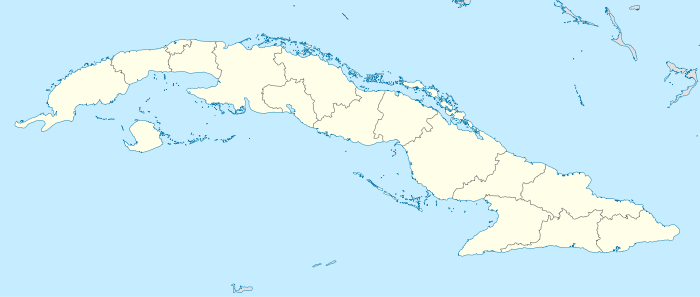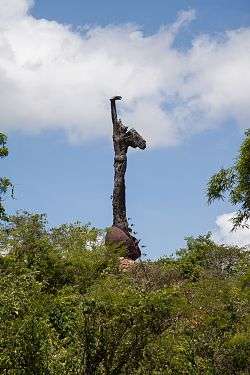El Cobre, Cuba
| El Cobre | |
|---|---|
|
Monument to the cimarrón | |
 El Cobre Location in Cuba | |
| Coordinates: 20°02′53″N 75°56′42″W / 20.048°N 75.945°WCoordinates: 20°02′53″N 75°56′42″W / 20.048°N 75.945°W | |
| Country | Cuba |
| Province | Santiago de Cuba |
El Cobre is a town in Cuba, until recently the site of a large copper mine worked by slaves, free coloured people, and for a while by miners from Cornwall. The town is now known mainly for a basilica in honour of the patron saint of Cuba.
History
Colonial era
The town of El Cobre grew up around the Cobre mine, the first open pit copper mine in Cuba.[1] It is about 12 miles (19 km) north west of Santiago Bay in the Sierra Maestra mountains.[2] Copper was first mined there in 1532.[3] The Spanish crown confiscated the mines in 1670 after the private contractor had failed to comply with the terms of his contract and had neglected them for years. 270 private slaves became the property of the king, and the town of El Cobre became a pueblo of king's slaves and free coloured people, a unique type of settlement in Cuba.[4] By 1730 El Cobre was one of just fourteen officially recognised settlements on Cuba, of which two or possibly three were Indian corporate pueblos.[5]
In 1780 an attempt was made to return the mine to private hands and increase production. By that time El Cobre had 1,320 inhabitants, including 64% royal slaves and 34% free coloured people, mostly manumitted descendents of slaves. 2% were the private slaves of the free coloured people. The men were mostly engaged in subsistence agriculture, while mining was mainly undertaken by the women. For much of this period the Cobre mine was the only source of copper on the island, supplying Cuba and sometimes other places in the Caribbean.[4]
The first great uprising of cimarrones, or escaped slaves, occurred in Cuba in the 18th century, and is commemorated by a large sculpture on a hill beside the town.[6] The 6 metres (20 ft) Monumento al Cimarrón was designed by Alberto Lescay Merencio and completed in 1997 as part of the UNESCO initiative to make people more aware of slavery. The inconspicuous location on a hill above the mine, was chosen by a local babalao, or Santería spirit guide.[7]
British mining
The mine had been abandoned by 1830.[8] The British El Compañía Consolidada de Minas del Cobre (Cobre Mining Company) acquired the mine and reopened it in the early 1830s. An adjacent concession was acquired and opened by the British El Real de Santiago (Royal Santiago Mining Company). Both companies turned to Cornwall for skilled labour and for steam engines to pump out the mines.[8] A Protestant burial ground was opened since the Cornish, considered heretics, could not be buried in the Catholic cemetery.[8]
Post-independence
The town was the location of one of the first uprisings in the Cuban War of Independence, on 24 February 1895, led by Colonel Alfonso Goulet with Rafael Portuondo Tamayo, delegate of the Cuban Revolutionary Party of the East.[9] In 1902, the mine was purchased by William A. Chanler, a wealthy New York businessman and a veteran of the Spanish–American War. Profits were initially robust enough that Chanler was able to loan $35 million to the Cuban government.[10] The mine was closed in 2001, laying off 325 workers. The quarry filled with water, which is high in minerals, particularly sulphur.[6] Today the town is mainly known for the Basílica Santuario Nacional de Nuestra Señora de la Caridad del Cobre, the Sanctuary of the Virgin of Charity.[1]
Notable people
- Luisa Pérez de Zambrana (1837-1922), writer and translator
References
- 1 2 Town and Mine of El Cobre – Slavery and Remembrance.
- ↑ Payton 2005, p. 113.
- ↑ El Cobre Mine ... Mindat.
- 1 2 Díaz 2006, p. 22.
- ↑ Díaz 2000, p. 10.
- 1 2 El Cobre mine might become ... tourist attraction.
- ↑ Twigg 2004, p. 43.
- 1 2 3 Cobre – The Cornish in Latin America.
- ↑ Guillermo Calleja Leal 1994, p. 6.
- ↑ Thomas 1971.
| Wikimedia Commons has media related to El Cobre, Cuba. |
Sources
- "Cobre", The Cornish in Latin America, University of Exeter, retrieved 2016-08-16
- Díaz, María Elena (2000), The Virgin, the King and the Royal Slaves of El Cobre: Negotiating Freedom in Colonial Cuba, 1670-1780 (PDF), Leland Stanford Jr. University, retrieved 2016-08-16
- Díaz, María Elena (2006), "Mining Women, Royal Slaves: Copper Mining in Colonial Cuba, 1670–1780", Mining Women: Gender in the Development of a Global Industry, 1670 to 2005, Palgrave Macmillan US, ISBN 978-1-349-73399-6, retrieved 2016-08-16
- "El Cobre mine might become Santiago de Cuba tourist attraction", Havana Journal, retrieved 2016-08-15
- "El Cobre Mine, Sierra Maestra Mts, Santiago de Cuba Province, Cuba", Mindat, Hudson Institute of Mineralogy, retrieved 2016-08-15
- Guillermo Calleja Leal (15 February 1994), Una revisión histórica del 24 de Febrero de 1895 ante el primer centenario de la guerra de Cuba (PDF), CESEDEN, retrieved 2016-08-16
- Payton, Philip (2005), The Cornish Overseas: A History of Cornwall's 'great Emigration', Dundurn, ISBN 978-1-904880-04-2, retrieved 2016-08-15
- Thomas, Lately (1971), The Astor Orphans: A Pride of Lions, W. Morrow, ISBN 1881324036
- "Town and Mine of El Cobre", Slavery and Remembrance, The Colonial Williamsburg Foundation, retrieved 2016-08-15
- Twigg, Alan (2004), 101 Top Historical Sites of Cuba, Dundurn, ISBN 978-0-88878-440-7, retrieved 2016-08-16
